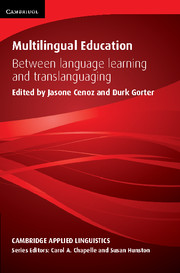Book contents
- Frontmatter
- Contents
- List of contributors
- Series editors’ preface
- Acknowledgements
- 1 Towards a holistic approach in the study of multilingual education
- 2 L1 as a pedagogical resource in building students’ L2 academic literacy: pedagogical innovation in the science classroom in a Hong Kong school
- 3 Linking content, linking students: a cross-linguistic pedagogical intervention
- 4 The role of the native language in the literacy development of Latino students in the United States
- 5 A nexus analysis of code choice during study abroad, and implications for language pedagogy
- 6 Multilingual practices in foreign language study
- 7 Language choices and ideologies in the bilingual classroom
- 8 Communicative repertoires in the community language classroom: resources for negotiating authenticity
- 9 Complementary classrooms for multilingual minority ethnic children as a translanguaging space
- 10 Constructing in-between spaces to ‘do’ bilingualism: a tale of two high schools in one city
- 11 Becoming multilingual and being multilingual: some thoughts
- Index
4 - The role of the native language in the literacy development of Latino students in the United States
Published online by Cambridge University Press: 17 September 2021
- Frontmatter
- Contents
- List of contributors
- Series editors’ preface
- Acknowledgements
- 1 Towards a holistic approach in the study of multilingual education
- 2 L1 as a pedagogical resource in building students’ L2 academic literacy: pedagogical innovation in the science classroom in a Hong Kong school
- 3 Linking content, linking students: a cross-linguistic pedagogical intervention
- 4 The role of the native language in the literacy development of Latino students in the United States
- 5 A nexus analysis of code choice during study abroad, and implications for language pedagogy
- 6 Multilingual practices in foreign language study
- 7 Language choices and ideologies in the bilingual classroom
- 8 Communicative repertoires in the community language classroom: resources for negotiating authenticity
- 9 Complementary classrooms for multilingual minority ethnic children as a translanguaging space
- 10 Constructing in-between spaces to ‘do’ bilingualism: a tale of two high schools in one city
- 11 Becoming multilingual and being multilingual: some thoughts
- Index
Summary
Introduction
English learners (ELs), particularly those from Hispanic backgrounds, represent one of the fastest-growing populations in the US public school system. The number of Latino students nearly doubled between 1990 and 2006, accounting for 60% of the total growth in public school enrolments over that period. Currently, 20% of the students attending US public schools are of Hispanic origin, and projections recently released by the US Census Bureau suggest that by 2050 there will be more Latino students in US public schools than those of European descent (Fry & Gonzales, 2008 ).
Despite the fact that the vast majority of the Latino K-12 students are US born, Spanish-speaking ELs lag behind native English speakers of the same age in text-level reading skills, and this puts them at risk of academic failure (August et al., 2005 ). As shown by results from the 2009 National Assessment of Educational Progress (NAEP), 39% of eighth-grade (ages 13–14) Latino students scored below the basic level in reading (Mather & Foxen, 2010 ). Raising the educational attainment of the fastest-growing segment of the population will be vital to the overall economic future and prosperity of the United States and as such should be a priority for education policy-makers.
While ELs exhibit word-level reading skills comparable to their English-only peers, their reading comprehension skills, which are necessary to master school work beyond third grade (ages 8–9) and have access to economic opportunity, are significantly lower (August & Shanahan, 2006 ). Differences in the reading performance of ELs and English native speakers begin to increase around Grade 4 or 5 (ages 10–11) when children transition from ‘learning to read’ to ‘reading to learn’, and these seem to be related to vocabulary and conceptual knowledge (Chall, 1983 ). Research on the acquisition of first language reading skills has demonstrated a strong relationship between knowledge of word meaning and ability to comprehend passages containing those words (Anderson & Freebody, 1981 ). In fact, the proportion of difficult words in a text has been found to be the single most powerful predictor of text difficulty, and a reader's general vocabulary knowledge the single best predictor of how well the reader can understand text (Anderson & Freebody, 1981 ).
- Type
- Chapter
- Information
- Multilingual EducationBetween Language Learning and Translanguaging, pp. 61 - 83Publisher: Cambridge University PressPrint publication year: 2015
- 19
- Cited by



